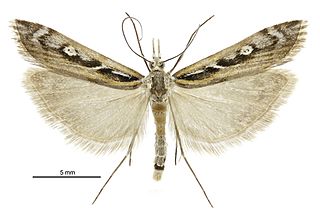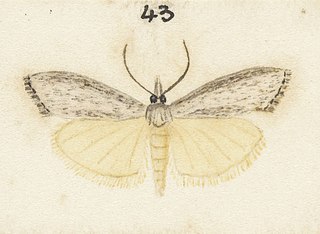
Laridae is a family of seabirds in the order Charadriiformes that includes the gulls, terns and skimmers. It includes around 100 species arranged into 22 genera. They are an adaptable group of mostly aerial birds found worldwide.

The genus Hylobates is one of the four genera of gibbons. Its name means "forest walker", from the Greek hūlē and bates.

Leucadendron is a genus of about 80 species of flowering plants in the family Proteaceae, endemic to South Africa, where they are a prominent part of the fynbos ecoregion and vegetation type.

Synallaxis is a genus of birds in the ovenbird family, Furnariidae.

Crambinae is a large subfamily of the lepidopteran family Crambidae, the crambid snout moths. It currently includes over 1,800 species worldwide. The larvae are root feeders or stem borers, mostly on grasses. A few species are pests of sod grasses, maize, sugar cane, rice, and other Poaceae. The monophyly of this group is supported by the structure of the tympanal organs and the phallus attached medially to the juxta, as well as genetic analyses.

Coeligena is a genus of South American hummingbirds.

The Inca jay is a bird species of the New World jays, which is native to the Andes of South America.

Cataclysta lemnata, the small china-mark, is a moth species of the family Crambidae. It is found in Europe, Morocco and Iran.
Cleoeromene is a monotypic moth genus of the family Crambidae described by David E. Gaskin in 1986. It contains only one species, Cleoeromene smithi, described by Herbert Druce in 1896 which is found in south-western Mexico, including Guerrero.

Kupea is a monotypic moth genus of the family Crambidae described by Alfred Philpott in 1930. It contains only one species, Kupea electilis, also known as Kupe's grassmoth, which is endemic to New Zealand. It is classified as Nationally Vulnerable by the Department of Conservation. The female of the species was first discovered in 2012.

Maoricrambus is a genus of moths of the family Crambidae. It contains only one species, Maoricrambus oncobolus, which is endemic to New Zealand. This species is classified as Nationally Endangered by the Department of Conservation.
Dioryctria cibriani is a species of snout moth in the genus Dioryctria. It was described by Akira Mutuura and Herbert H. Neunzig in 1986 and is known from Mexico.

Scoparia caesia is a moth of the family Crambidae. It is endemic to New Zealand.

Orocrambus jansoni is a species of moth in the family Crambidae. It is endemic to New Zealand. This species is classified as "At Risk, Naturally Uncommon" by the Department of Conservation.

Orocrambus ornatus is a moth in the family Crambidae. This species is endemic to New Zealand. It is classified as critically endangered by the Department of Conservation.

Orocrambus sophronellus is a moth in the family Crambidae. This species is endemic to New Zealand. This species has been classified as Data Deficient by the Department of Conservation.
Neoeromene octavianella is a moth in the family Crambidae. It was described by Philipp Christoph Zeller in 1877. It is found in Panama.
Neoeromene parvalis is a moth in the family Crambidae. It was described by Francis Walker in 1866. It is found in the upper Amazon region, where it has been recorded from Brazil and Peru.
Neoeromene parvipuncta is a moth in the family Crambidae. It was described by David E. Gaskin in 1986. It is found in Paraná, Brazil.

Protea madiensis, commonly known as the tall woodland sugarbush, is a flowering shrub which belongs to the genus Protea. It is native to the montane grasslands of Sub-Saharan Africa.














